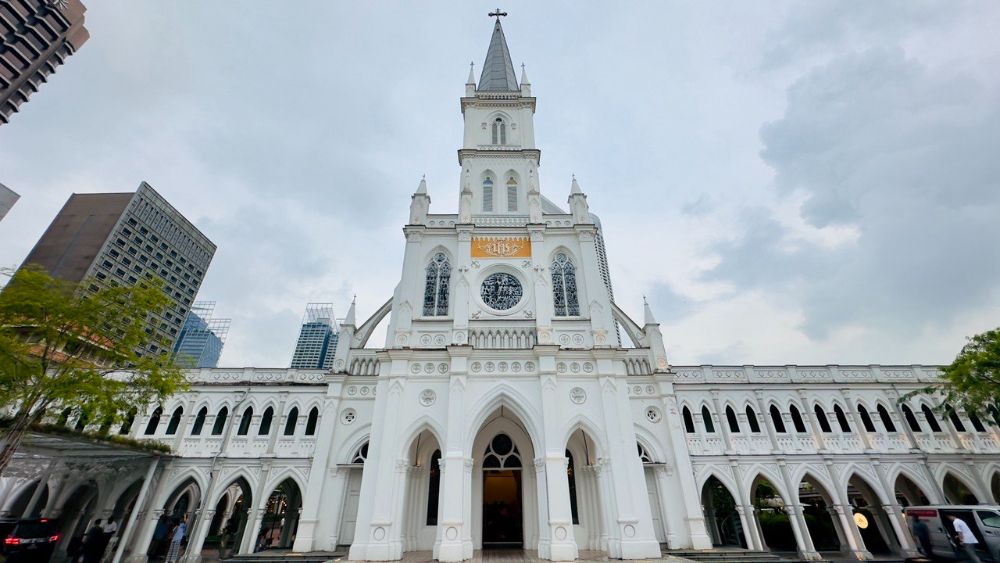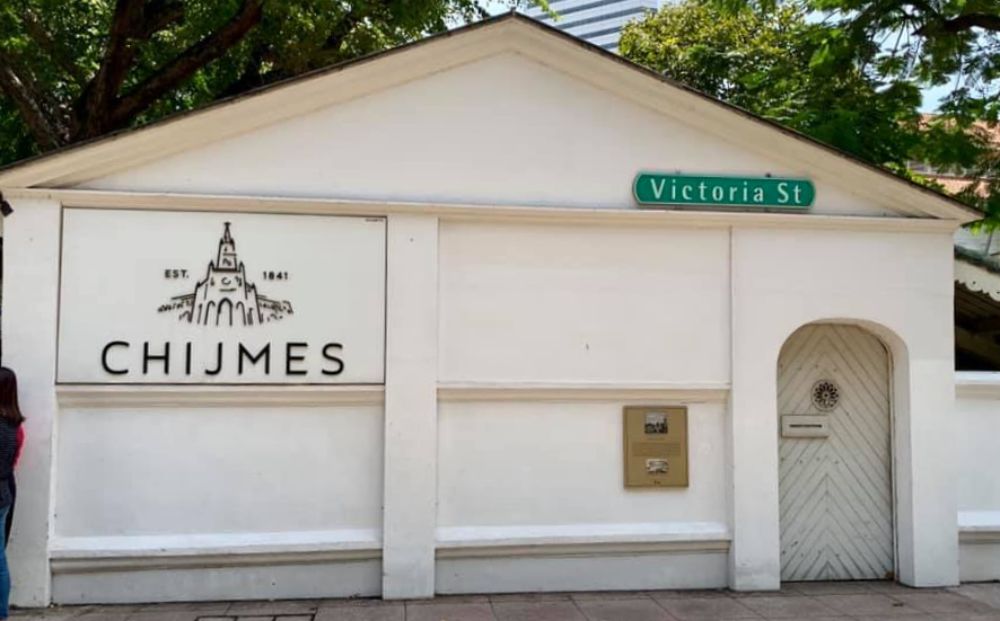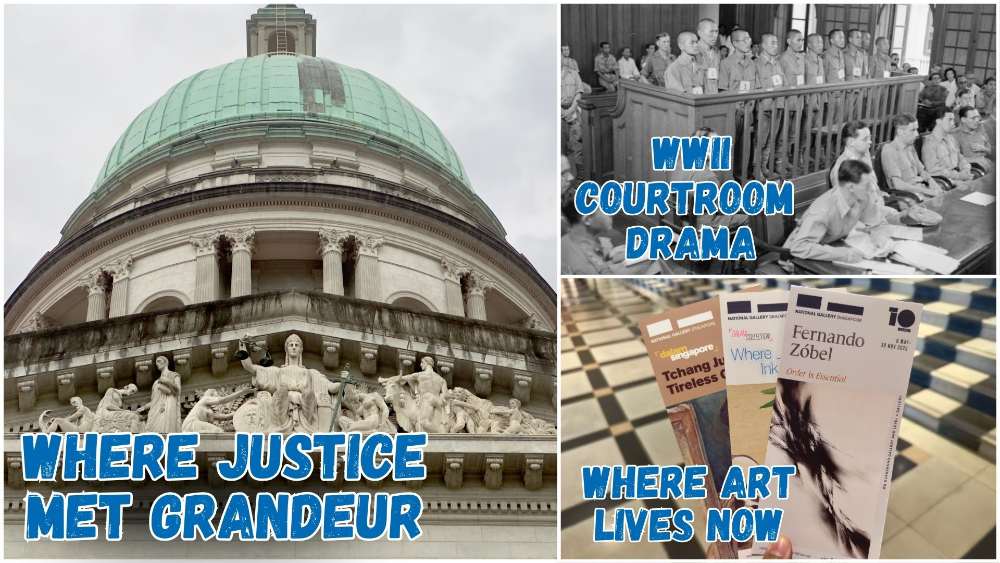National Monuments Of Singapore: Former Convent of the Holy Infant Jesus Chapel and Caldwell House
What is a National Monument? Who gazettes them? How many national monuments are there in Singapore? To date, the Preservation of Sites and Monuments, a division of National Heritage Board, has identified and gazetted 75 buildings, structures and sites of national significance as an integral part of Singapore’s built heritage.
And we're here to tell you all about them - one National Monument at a time!
You've probably passed by or stepped into more than a few of them without realising they were National Monuments: Al-Abrar Mosque, Asian Civilisations Museum, the Civilian War Memorial, Saint Andrew's Cathedral, the Esplanade Park Memorials, Fort Siloso on Sentosa - no need to plan an itinerary for friends visiting from overseas; just show them this article ✌️
In this edition, we zoom in on a complex that once housed the oldest Catholic girls' school in Singapore, the Former Convent of the Holy Infant Jesus Chapel and Caldwell House (known today as CHIJMES).
📍 Location
The Former Convent of the Holy Infant Jesus Chapel and Caldwell House was the 23rd building to be gazetted as a National Monument, and is located near other National Monuments such as Cathedral of the Good Shepherd, Raffles Hotel and Civilian War Memorial. The MRT stations nearest to it are City Hall and Esplanade.
📅 Significant dates
Dates built:
- 1840-1841: Caldwell House was built
- 1903: The chapel was constructed
Milestones:
- 1854: The Convent of the Holy Infant Jesus was founded in Caldwell House
- 11 Jun 1904: The chapel was consecrated
- 3 Nov 1983: Mass was held in the chapel for the last time
- 1996: The complex re-opened as CHIJMES
Date gazetted: 26 Oct 1990
📜 History
The beginnings of the Convent of the Holy Infant Jesus can be attributed to a French priest, MEP Reverend Father Jean-Marie Beurel. ("MEP" is short for "Société des Missions Etrangères de Paris" or "Society of Foreign Missions of Paris", a Catholic missionary organisation.) He was also responsible for the construction of the Church of the Good Shepherd and the founding of Saint Joseph’s Institution.
Under the instruction of Bishop Jean-Baptiste Boucho (the Penang-based Vicar of Malaya), Father Beurel visited France in 1851 to recruit teachers to set up new mission schools in the region. There, he successfully sought help from the Institute of the Brothers of the Christian Schools (or, simply, the Christian Brothers, who later started Saint Joseph’s Institution in Singapore) and the Congregation of the Holy Infant Jesus.
Four sisters returned to Singapore with Father Beurel. Unfortunately, the group’s superior died after five months at sea, while another sister contracted brain fever. A third left her duties upon reaching Singapore. With only one sister left, it was impossible to start a school. More help was requested. Another four sisters then travelled the overland route to Penang via the deserts of Egypt.
In January 1854, a new party of sisters arrived in Penang. It was then that four sisters, led by Reverend Mother Mathilde Raclot, embarked on their journey to Singapore.
When they arrived in Singapore on 5 Feb 1854, the sisters moved into the Neo-Classical bungalow that is now known as Caldwell House. According to many accounts, Father Beurel had used his own money to buy the residence from its namesake, a clerk to the Registrar. This marked the founding of the Convent of the Holy Infant Jesus (CHIJ). The community of sisters also went on to found several other convent schools in Singapore.
A verse echoing God’s words to Abraham in the Book of Genesis can be seen on the wall – Marche en ma présence et sois parfait (“Walk before me, and be perfect”). It served as a constant reminder to the sisters of their spiritual obligation to strive for perfection.
The sisters are also remembered for taking in abandoned children who were left outside the convent, in front of a little door aptly named the "Gate of Hope" along Victoria Street. Many died after being abandoned, with some already dead upon arrival. Those who survived, learned vocational and domestic skills and received a free education at the school. The orphanage or convent crèche closed when the convent schools moved out of Victoria Street in 1983.
A two-storey orphanage, located behind Caldwell House and the chapel, was built circa 1856.
When the chapel was completed in 1903, and later consecrated in 1904, it was undisputedly one of the grandest religious buildings in Singapore. The names of the benefactors who contributed generously to its construction were inscribed on the stone plaques set in the walls on both sides of the entranceway.
When the First World War broke out, the chapel's designer Father Nain (more on him in the next section) enlisted for military service and was posted to a medical unit. He later died on the battlefield in Vichy, France. A memorial plaque in his honour can be found in the chapel, and his name was also engraved on the bronze plates at the Cenotaph.
As people began moving out of the town area into the suburbs, the convent school likewise shifted to its new premises in Toa Payoh in 1983 and was renamed the Convent of the Holy Infant Jesus (Toa Payoh). The last Holy Mass was celebrated in the chapel on 3 Nov 1983 before it was deconsecrated.
The former convent compound was restored and renamed CHIJMES (pronounced ‘chimes’). It now houses retail outlets, restaurants, and bars.
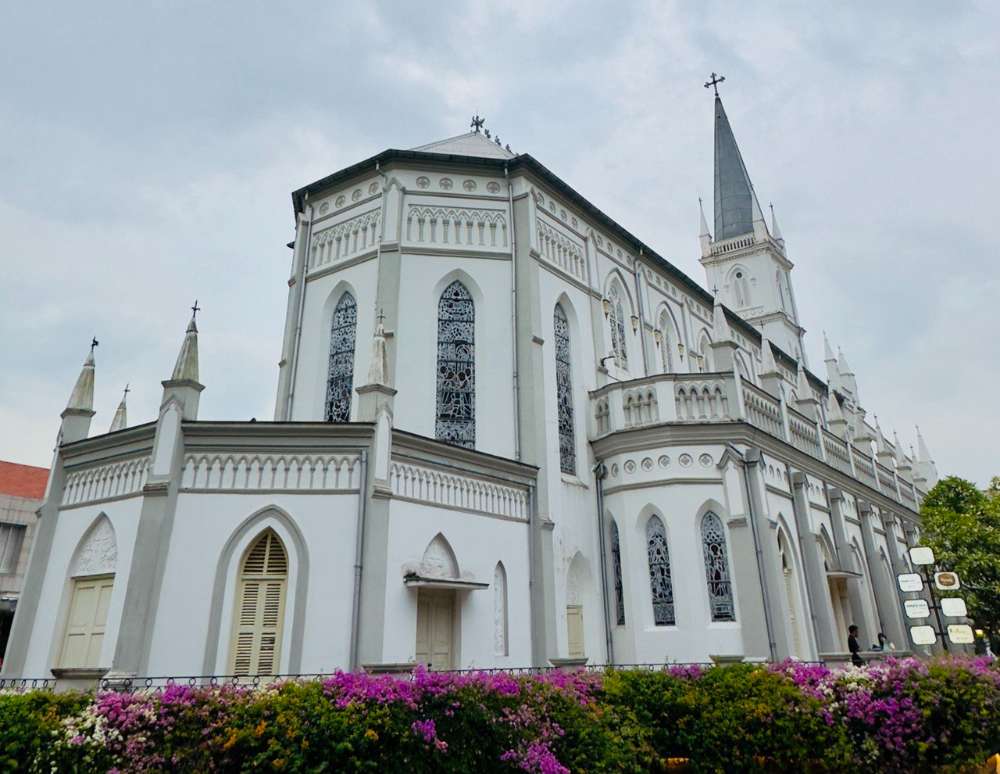 IMAGE: NG KAI
IMAGE: NG KAI
📐 Design and architecture
Flanked by walkways, the charming Anglo-French Gothic chapel was designed by Reverend Father Charles B. Nain, who was then serving at the Church of Saints Peter and Paul. Father Nain was also responsible for designing the curved wings of the Former Saint Joseph’s Institution and the Church of the Nativity of the Blessed Virgin Mary. The chapel has a five-storey high spire over the entrance and decorative flying buttresses on each side.
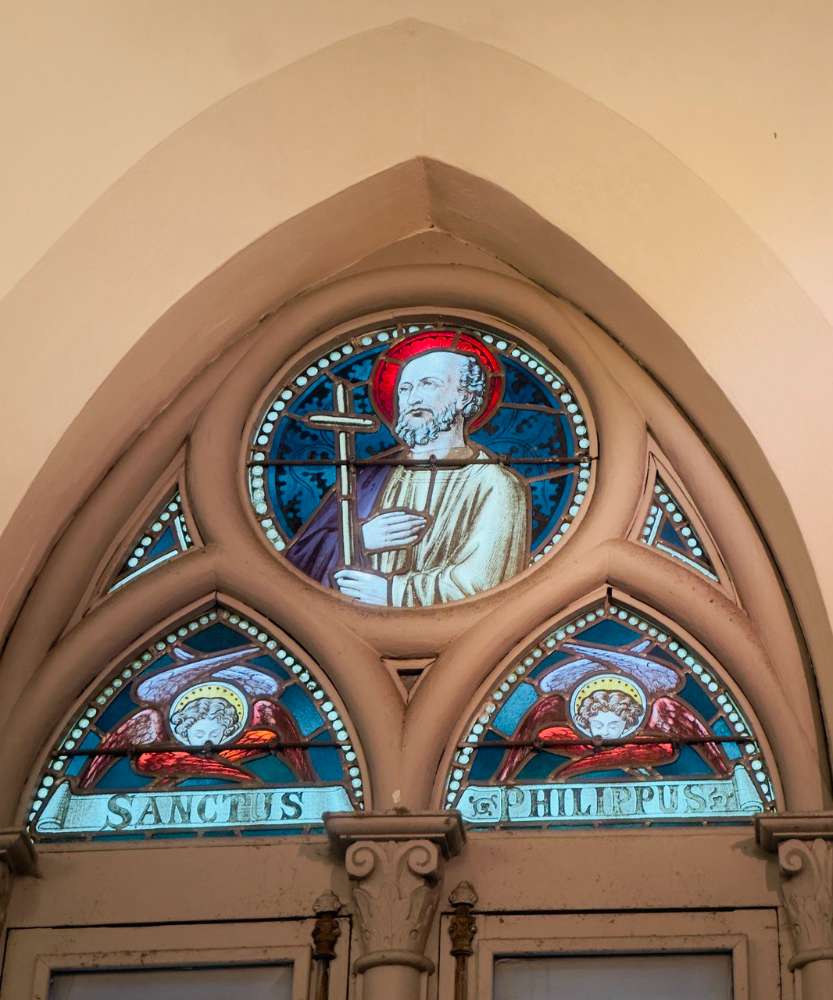 IMAGE: NG KAI
IMAGE: NG KAI
The stunning stained-glass windows were manufactured in Bruges, Belgium by the famed and highly-skilled European craftsman, Jules Dobbelaere, who was also commissioned to make the stained-glass windows in Saint Joseph’s Church.
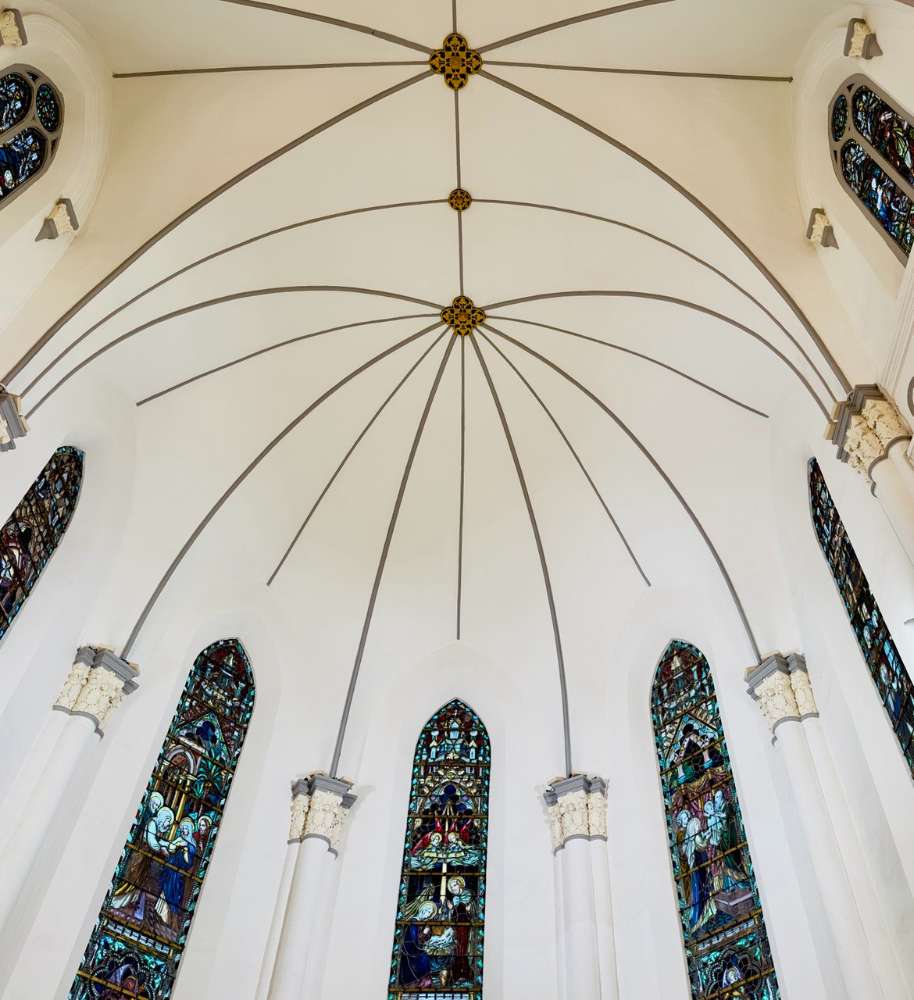 IMAGE: NG KAI
IMAGE: NG KAI
Among the stained-glass collection in the chapel are the windows at the apse (a part of a building that sticks out from one end of the building, is usually semicircular, has an arched roof, and is often richly decorated especially in Gothic churches) showing the life events of Jesus: the Annunciation, the Visitation, the Nativity of Jesus, the Presentation of Jesus, and the Finding of Jesus in the Temple. Stained-glass panels above the windows on either side of the nave depict the Twelve Apostles.
Colourful terrazzo tiles cover the floor of the chapel. Carved letters on the chapel facade stand for Iesu Homine Salvator (Latin for “Jesus, Saviour of the World”). Each of the 648 columns of the building and linkways feature unique, intricate carvings of tropical birds and plants.
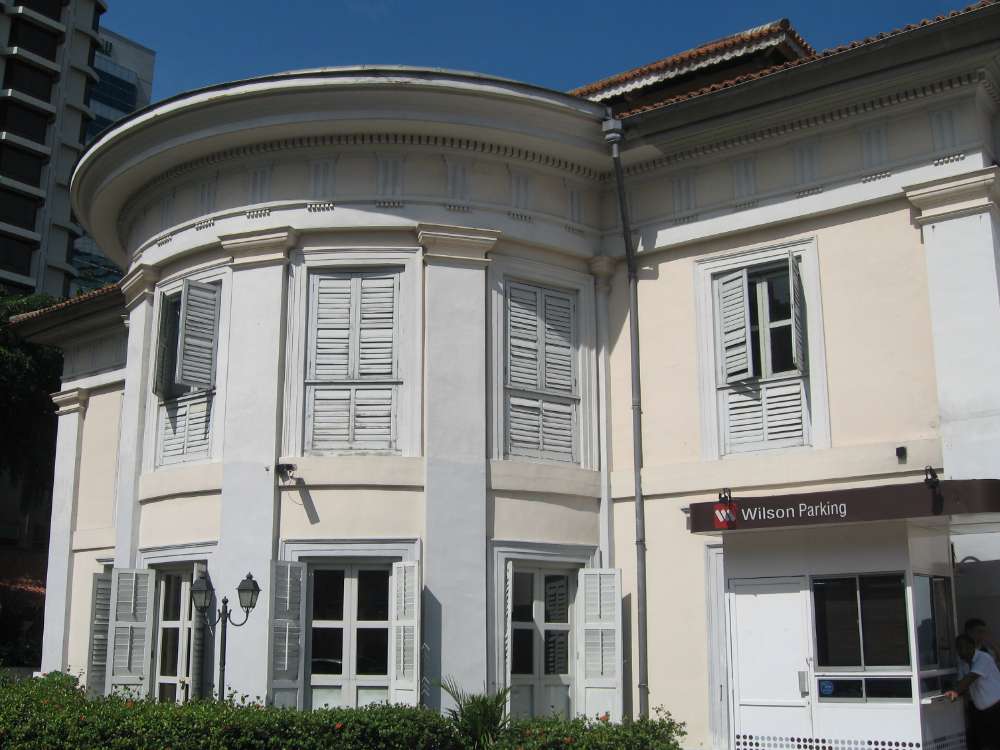 IMAGE: WIKIMEDIA COMMONS/@TERENCE ONG
IMAGE: WIKIMEDIA COMMONS/@TERENCE ONG
Caldwell House is the oldest building in the compound. It was designed by George D. Coleman, the first Superintendent of Public Works in Singapore, whose other works include the Armenian Church, the first Saint Andrew’s Church, and the Former Parliament House. Covered with a prominent jack roof, the bungalow has numerous large French windows with louvres to ensure that the interior was well ventilated in Singapore’s tropical climate.
An interesting architectural element of Caldwell House is the semi-circular projection that faces Victoria Street. For decades, the sisters had used the upper bay as a lounge where they sewed, read, wrote, and marked the scripts of their students.
🕖 Opening hours
Regular visiting hours for the chapel are from 10am to 7pm on all days except Sunday (9am to 6pm).
Regular visiting hours for Caldwell House are from 9am to 6pm daily.
🎟️ Admission
Entry is free.
For the latest updates on Wonderwall.sg, be sure to follow us on TikTok, Telegram, Instagram, and Facebook. If you have a story idea for us, email us at [email protected].







